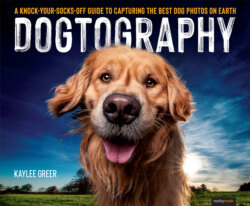Читать книгу Dogtography - Kaylee Greer - Страница 13
На сайте Литреса книга снята с продажи.
LET’S TALK DOG BODY LANGUAGE
ОглавлениеThis is a book for photographers, not biologists. (Although if you happen to be a photographer-biologist, well then that’s rad and you are still very much welcome here.)
To preface this chapter—If you’re looking for in-depth reading on the subject, I highly recommend renowned Animal Behaviorist Alexandra Horowitz’s book Inside of a Dog. I feel it should be required reading for anyone looking to work with dogs in any capacity.
That said, this is less of a chapter in a science textbook and more of a quick rundown of the basics that we need to know in order to respect and communicate with dogs as subjects of our photography. It would be easy to write an entire Lord of the Rings-length epic on this subject alone, so I’ll tame it down to the absolute basics here.
While dogs are mostly known to us as our domesticated canine best friends, it’s easy to forget that dogs are still live animals of an entirely different species. It’s important to understand that we need to take precaution when working with live animals in order to keep everyone safe while on-location.
Remember, in the history of the world, dogs were only very recently domesticated as human companions. They are direct descendants of the wolf. No matter how much we try to manipulate, change, and rearrange them through selective breeding, they will never fully lose the genetic and historical connection to their wild ancestors.
Throughout the course of your dog photography adventures, you are going to meet and work with all kinds of dogs. Happy dogs. Calm dogs. Wild dogs. Fearful dogs. Big dogs. Little dogs. Proud dogs. Barking dogs. Spotted dogs. Curly dogs. Handicapped dogs. Agility dogs. Service dogs. Shelter dogs. Senior dogs. You get the picture. Some of them will be a breeze to photograph. Some of them won’t even notice you’re there. Some of them won’t let you within five feet of where they stand. Some of them will bowl you over and cover you with slobbery love anytime you’re within eyesight. Dogs and their varying, unique personalities go on and endlessly on. Like human beings, dogs are individuals, and we must respect them as such. They all come with their own stories and histories. Some will be so easy to photograph that we’ll dust our shoulders off at the end of a long shoot and smile smugly. Others will test our resilience and our expertise. They will be so hard to work with that you’ll burst into tears and question every reason why you ever thought you could be a dog photographer.
We must know how to work with them all. Every dog deserves to have their story told.
1.1
In this chapter we’re going to look at some very specific dog body language scenarios as they relate to photography. We’ll learn what signs to look for, what they could mean, and what we as photographers can do to ensure we’re respecting those signs. Not only will this help us to work safely, but the resulting images will show that we can really speak dog.
Let’s start by addressing the obvious. Photographing dogs is hard. Like, really hard. The idea of capturing still images of a constantly moving, fur-covered subject that doesn’t speak the same language as us is a tough nut to crack in and of itself. But more than that, there’s an even bigger challenge that we are presented with before we even leave the house. It has directly to do with a certain primal instinct that comes built into each and every dog we meet.
In dog body language, staring directly toward or into another dog’s eyes is considered extremely aggressive. This is usually the last interaction that occurs before a fight breaks out between two (or more) dogs. What does this mean for us? You guessed it. As photographers, we’re at a disadvantage before we even step into the ring because what does our lens (smooshed directly into the face of an unassuming dog) resemble?
That’s right. A big, giant eye.
It may seem like innocent fun and games to us. “Just a nice new DSLR and a couple of lenses while I lean in to snag a quick shot—no pressure Fido!”
But, here’s what it looks like from the perspective of a dog.
Horrifying.
1.2
As you can see, photo shoots are inherently a strange experience for dogs. It’s a break from their daily routines (stressful), perhaps taking place in unfamiliar surroundings (stressful), heavily featuring a new human who puts a large clicking black box in front of their face while demanding endless sits and stays (super stressful). So, what can we do to take all of this strangeness and turn it into a wonderful experience? How can we master our images but also master managing the happiness and comfort of all the very good boys and girls that will find their way in front of our lenses? Good question! The first and absolute most important thing we’ll talk about in this section is energy.
